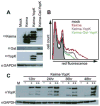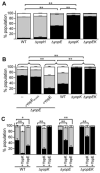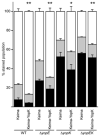YopK regulates the Yersinia pestis type III secretion system from within host cells
- PMID: 21205017
- PMCID: PMC3210821
- DOI: 10.1111/j.1365-2958.2011.07534.x
YopK regulates the Yersinia pestis type III secretion system from within host cells
Abstract
The pathogenic Yersinia species share a conserved type III secretion system, which delivers cytotoxic effectors known as Yops into target mammalian cells. In all three species, YopK (also called YopQ) plays an important role in regulating this process. In cell culture infections, yopK mutants inject higher levels of Yops, leading to increase cytotoxicity; however, in vivo the same mutants are highly attenuated. In this work, we investigate the mechanism behind this paradox. Using a β-lactamase reporter assay to directly measure the effect of YopK on translocation, we demonstrated that YopK controls the rate of Yop injection. Furthermore, we find that YopK cannot regulate effector Yop translocation from within the bacterial cytosol. YopE is also injected into host cells and was previously shown to contribute to regulation of the injectisome. In this work we show that YopK and YopE work at different steps to regulate Yop injection, with YopK functioning independently of YopE. Finally, by expressing YopK within tissue culture cells, we confirm that YopK regulates translocation from inside the host cell, and we show that cells pre-loaded with YopK are resistant to Yop injection. These results suggest a novel role for YopK in controlling the Yersinia type III secretion system.
© 2011 Blackwell Publishing Ltd.
Figures








References
-
- Aili M, Hallberg B, Wolf-Watz H, Rosqvist R. GAP activity of Yersinia YopE. Methods Enzymol. 2002;358:359–370. - PubMed
-
- Aili M, Isaksson EL, Carlsson SE, Wolf-Watz H, Rosqvist R, Francis MS. Regulation of Yersinia Yop-effector delivery by translocated YopE. Int J Med Microbiol. 2008;298:183–192. - PubMed
-
- Ben-Gurion R, Shafferman A. Essential virulence determinants of different Yersinia species are carried on a common plasmid. Plasmid. 1981;5:183–187. - PubMed
-
- Black DS, Bliska JB. The RhoGAP activity of the Yersinia pseudotuberculosis cytotoxin YopE is required for antiphagocytic function and virulence. Mol Microbiol. 2000;37:515–527. - PubMed
-
- Boland A, Havaux S, Cornelis GR. Heterogeneity of the Yersinia YopM protein. Microb Pathog. 1998;25:343–348. - PubMed
Publication types
MeSH terms
Substances
Grants and funding
LinkOut - more resources
Full Text Sources
Other Literature Sources
Medical

